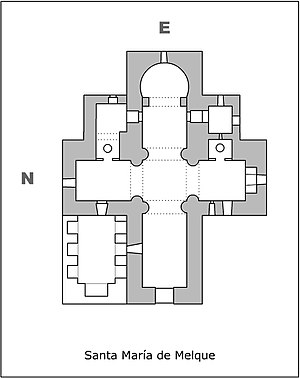This article has multiple issues. Please help improve it or discuss these issues on the talk page. (Learn how and when to remove these messages)
|
Santa María de Melque is a church located near the town of San Martín de Montalbán in the province of Toledo in Spain. Included in the Monastic Complex of Melque, it is considered "the best preserved exponent of the constructions and establishment of religious complexes in the early 8th century in the region of Toledo". The church is the biggest fully-vaulted early medieval church still standing in Western Europe.
Following its acquisition by the Toledo Provincial Council, the complex was excavated and restored. An interpretation centre has also been set up.
History

There was originally a Roman settlement at the location, with five dams across the two brooks that surround a small, rocky hill. Santa María de Melque came into being as a monastic collection inside the Catholic Kingdom of Toledo. Construction commenced in the 7th century, coinciding with the end of the Visigothic kingdom. It has been argued that construction came to a halt with the arrival of the Arabs, to be continued later, although there is a counter-argument that the architecture shows Syrian influence (specifically Syro-Umayyad). It appears that there was an Islamic settlement at Melche in the 8th century.
With the conquest of Toledo by King Alfonso VI of León and Castile in 1085, the temple recovered its liturgical function without losing its military function. The anthropomorphic tombs located to the east and the remains of barbicans are testimonies of this historic period.
Worship at the site ceased in the 19th century following its "confiscation" as part of the widepread secularisation of religious sites at the time.
Architecture

Completed in the 8th century, the church is the first one-half monument better preserved of the Spanish High Middle Ages. Its constructive technique is the direct inheritance of late Roman architecture. However, the lack of decorative elements preserved (filigrees of stucco in the transverse arches of the crossing) that still can be seen in the background of the southern arm of the crossing suggests that Melque could be at first a mausoleum, destined to burial of a distinguished personage from Toledo's Visigothic Kingdom. The church was later redesigned on at least two occasions.
The Knights Templar turned the church into a defensive tower, referred to by Romans as a turris. This tower over the dome base was recently dismounted. It had a porch with three openings, which no longer exists.
The plan is cruciform, with a central apse; two lateral apses were added later. It keeps in good condition its different naves, some side chapels and a parlor with pronounced horseshoe arches.
The presbytery is large corresponding to a monastic community with round arches at both sides. A moorish tower is also preserved over the vault.
This church has contributions of clearly Visigothic style, new solutions contributed by the Mozarabs, and memories of the Roman style:
- Visigothic contributions: the horseshoe arch that supports the apse's vault, surpassing 1/3 of the radium. The set unprovided of remains sculptured, of Visigothic tradition. The arcosolium.
- Mozarabic contributions: central horseshoe arches of surpassing 1/2 of the radium. Arches of the windows in 2/3. Strange semicircular pilasters of the inside that neither may be considered semi-detached.
- Innovations: the circular reduction of the corners in its 4 facades and the vertical crack at both sides, having the appearance of pseudo columns. It looks like the columns placed at the corners of the lantern towers of Romanesque Norman style. It's an unprecedented solution.
References
- ^ "Group of Mozarabic buildings on the Iberian Peninsula". UNESCO. Retrieved 2019-06-15.
- Garen, Sally. "Santa María De Melque and Church Construction under Muslim Rule." Journal of the Society of Architectural Historians 51, no. 3 (1992): 288-305. doi:10.2307/990688.
External links
- Tourism site
- Photographic journey through the Spanish Visigothic church of St. Mary of Melque.
39°45′03″N 4°22′23″W / 39.75083°N 4.37306°W / 39.75083; -4.37306
Categories: